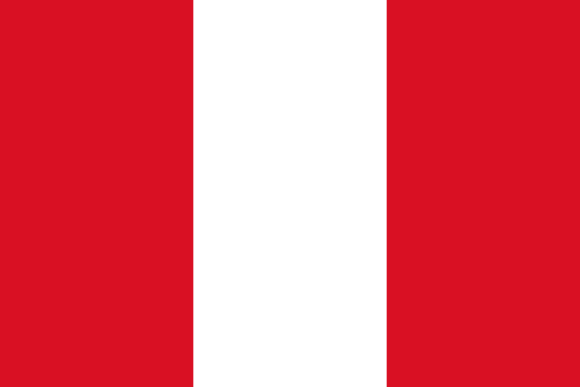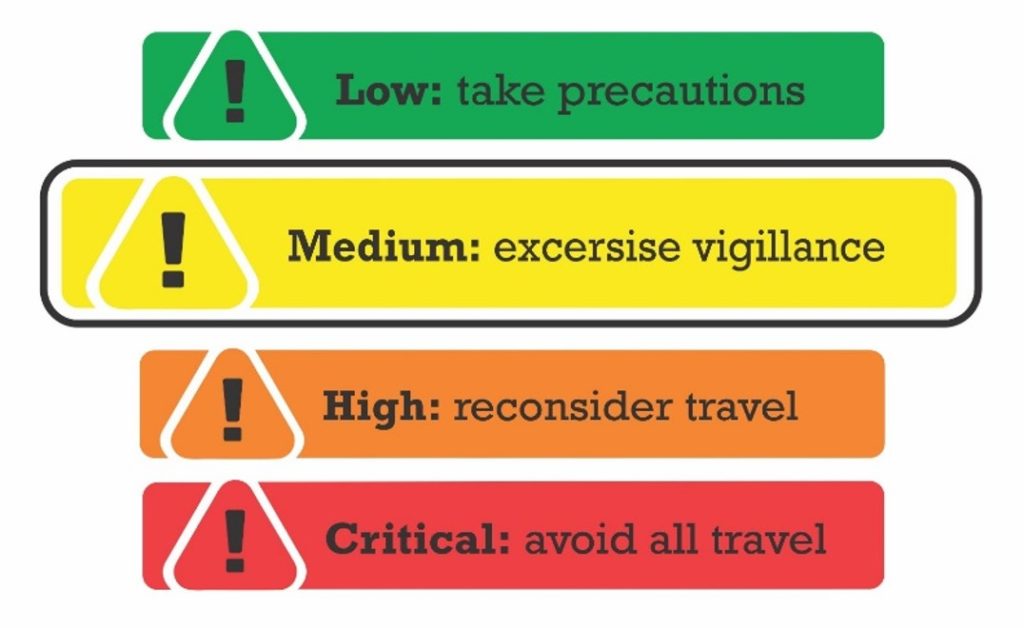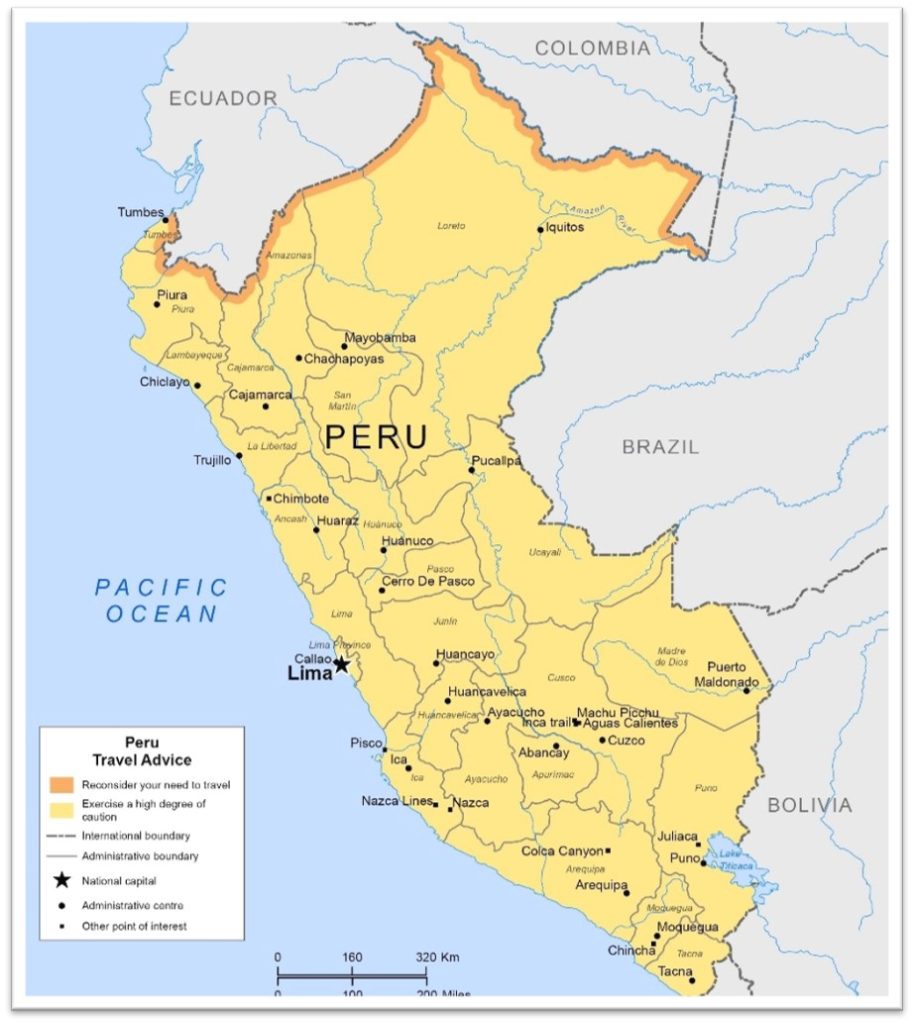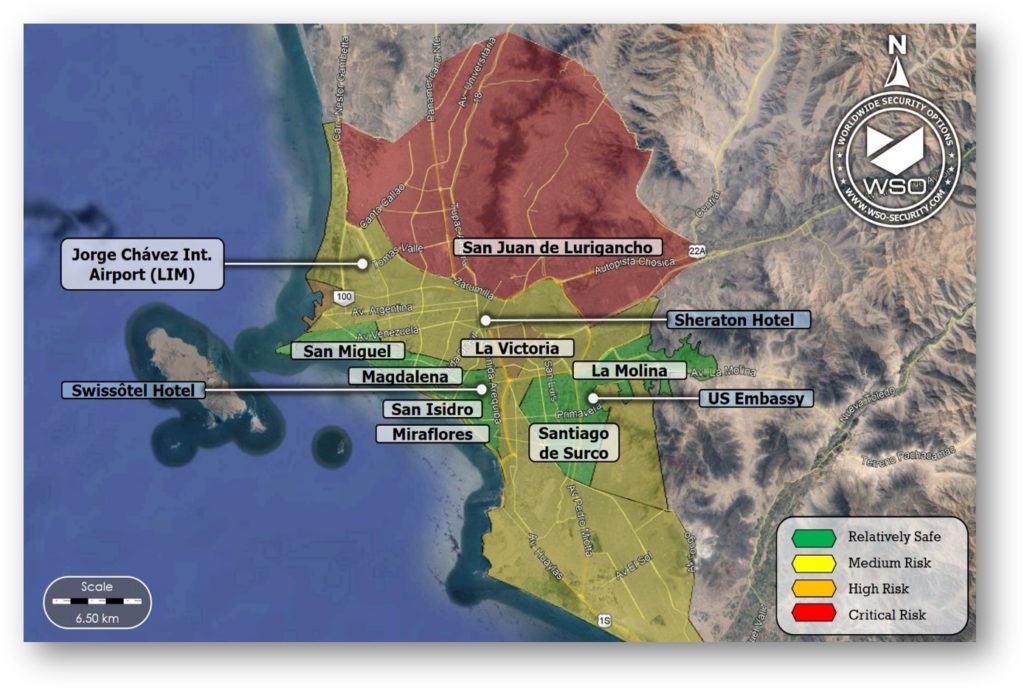| Official Name: | Republic of Peru |
| Official Language: | Spanish |
| Area: | 1,285,216 km2 (496,225 sq mi) |
| Population: | 32,900,000 |
| Time Zone: | UTC−5 |
| Capital City: | Lima |
| Height (Lima): | 0-1,550 m (0-5,090 ft) |
| Currency: | Sol (PEN) |
| Main Cities: | Lima, Arequipa, Trujillo |
| Main Port: | Port of Callao |
| Required visa for entry: | Nationals from Canada, EU countries, and the UK and others DO NOT require visas. Click here for more information concerning visa requirements. |
| Required vaccination for entry: | None |

Main Risks:
Theft, robbery, kidnapping, extortion, rape, drug and human trafficking, fraud, vehicle assault.
Executive Summary
Peru features intermediate risks chiefly associated with the possibility of suffering armed and unarmed robbery at the hands of common criminals or organized gangs. Security risks increase if itineraries involve road travel through the countryside areas, especially along the border areas and within the Valley of the Apurímac, Ene and Mantaro rivers (VRAEM). The later is considered one of Peru’s most undeveloped regions, where armed militant remnants from Shining Path (Sendero Luminoso) continue to operate. In case of high-profile travel, we recommend hiring secure transportation or protection services, especially if the itinerary requires travel to rural areas via land routes.

General Risk Level: MEDIUM.
Although the risk level nationwide generally stays medium, the security situation can change significantly in remote areas. It is thus necessary to plan ahead before traveling to places removed from the largest urban centers.

Crime and Security
Similar to what transpires in other Latin American countries, low and medium-level crime represents the main threat to travelers visiting Peru. The risk of suffering robbery is higher in the largest urban areas, mainly in the Lima-Callao metropolitan area. There is a distinct risk of suffering short-term “express” kidnapping. Whether planned or committed at random, criminals seek to force their victims to extract cash from ATMs before being released. Criminals often resort to operating either registered of fake taxis, taking advantage of their victim’s carelessness to transport them to remote areas beyond police control. Foreigners and locals alike are liable to be targeted.
Political rallies and events are usually peaceful. That said, it is known that during crisis periods violent incidents are likely to occur, especially clashes between radicalized activists and security forces. Police response to such challenges varies but in given circumstances can involve tear gas and water cannons to disperse unruly demonstrators. As a rule of thumb, for security reasons, it is best to avoid the vicinity demonstrations.
National police have a tourist police unit (Poltur) that operates in sites frequented by foreigners, including the ruins at Machu Picchu and the beachside corridor in Lima, between the Jorge Chávez International Airport (LIM) and prominent hotels in the Miraflores and San Isidro districts. Nonetheless, visitors should be advised that even relatively safe areas can witness crime activity and violent incidents. Besides low and medium-level crime, drug trafficking is a recurrent threat to national security. Peru is the second-largest cocaine producer in the world. Traffic routes go mostly to countries in the south, especially Bolivia. In any case, clashes between rival gangs on Peruvian streets are not as recurrent as in other countries.
Security in Lima
As a rule of thumb, the safest neighborhoods in Lima are adjacent to the shoreline. The areas recommended for lodging, travel, and conducting business and transactions are Miraflores, Magdalena, San Miguel, La Perla, Santiago de Surco, La Molina, and San Isidro (Central Business District – CBD). These areas are perceivably safer than others because they are better protected by security forces and private security agents. That said, it is recommended to exercise constant vigilance. Even the most privileged sites can witness violent crimes. The Jorge Chávez International Airport (LIM) is located in the city of Callao, within Lima’s metropolitan area. The trip between the airport and the business district in San Isidro usually takes 45 minutes depending on traffic. Please be advised that the northeastern areas of Lima are especially vulnerable to violent crime and should thus be avoided.

Transportation
For security reasons, we do not recommend using public transportation services in Peru. We advised hiring reputable private transportation services in advance. In the event of high-profile visits, it is best to procure private protection services.
The best option for intercity travel is to take commercial flights. For tourist trips to the Machu Picchu ruins travel to Cusco is required. Although routes are generally in good condition, traveling through sparsely populated areas with adverse topography entails security risks, especially during the night or under conditions of poor visibility. Therefore, if traveling by land, do not deviate from primary thoroughfares or highways. It is best to avoid secondary routes removed from central localities and which remain in poorer circumstances.
If the itinerary does involve travel through remote or sparsely populated areas, make sure to plan the route in advance under the supervision of local security professionals. Educated assessments should enable the security contractor to determine the safest route and avoid unilluminated or otherwise dangerous paths.
Health and Sanitary Conditions
Peru features changing temperatures and travelers may suffer altitude sickness. Travelers should pay attention to meteorological conditions and avoid touristic trips during the rainy season.
While no proof of vaccination is required for entry into the country, it is recommended to have the following vaccines before traveling: yellow fever, tetanus, hepatitis A and B, and typhoid. It is also necessary to wear protection against bugs and avoid leaving body areas uncovered to mitigate the risk of suffering mosquito-borne diseases such as dengue, the Chagas disease, and the zika virus. These precautions must be followed while entering remote and jungle areas. The quality of tap water in Peru is relatively high because it comes from the Andes mountains. However, while staying in remote areas it is always best to resort to sealed bottled water. It is not advised to travel without international health insurance covering emergency medical evacuation to the country of origin.
Take essential health precautions to mitigate the risk of contracting diseases or viruses. Carry masks in crowded places such as airports and maintain rules of social distance and avoid contact with surfaces of common use in public places. Always carry hand sanitizer.
Tactical Recommendations
Exercise vigilance and situational awareness throughout the trip to Peru, especially in urban areas vulnerable to low and medium-level criminal activity. Avoid travel to high and critical risk areas. Avoid all travel to border areas with Ecuador and Colombia. In Lima, avoid all unnecessary travel to peripheric neighborhoods, especially in the northeastern parts of the city.
We recommend hiring private transportation and executive protection services for high-profile trips, especially if travel through the countryside is required.
Avoid carrying large sums of cash or valuables during the trip. We advise against wearing or carrying items in public that may give the impression of economic affluence and which could attract unwanted attention from criminals.
Avoid traveling through the country in sport or luxurious cars which could attract unwanted attention from criminals and corrupt police officers.
Do not resist armed robbery attempts. We recommend to always carry a few 200-soles (PEN) bills or 50-USD bills for duress cases, specifically to appease criminals looking for easy money.
For security reasons avoid travel during night hours, even in Lima.
We recommend lodging in reputable establishments and hotels with private security. In Lima, it is best to stay along the shoreline districts of San Miguel, Magdalena, Miraflores or San Isidro, where some of the main hotels are located.
If private transportation services are unavailable, resort to reputable radio taxi companies, provided they are recommended by the best hotels. Stay alert at all times while traveling by taxi to prevent the driver from taking unnecessary detours or from inflating the fare.
If travel by route through the countryside is required, avoid all detours, especially while traveling through sparsely populated rural or jungle zones. If possible, plan routes and stopovers ahead with the support of a local security contractor.
Avoid the vicinity of every kind of political demonstration or rally in urban areas. Peaceful demonstrations are liable to be infiltrated by violent elements. Take all necessary precautions to mitigate the risk posed by mosquito-borne diseases. Moreover, taking into account the risk of altitude sickness, we recommend consulting a physician before travel to Peru takes place.
Emergency Contacts
Police: 105
Ambulance: 106
Fire: 116
WSO Global Command Center: +1 956 467 4858 / gcc@wso-security.com
Security advice and assistance over WhatsApp: +593 99 461 1128 / +521 81 1511 3166




